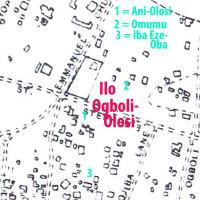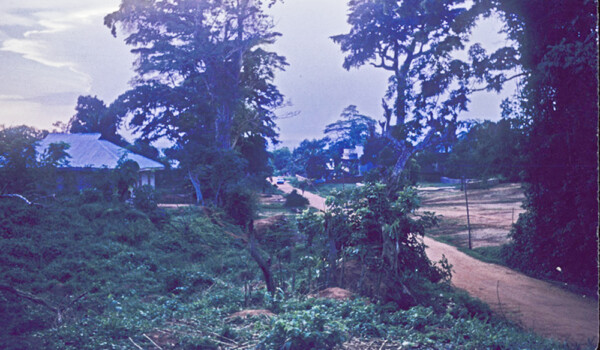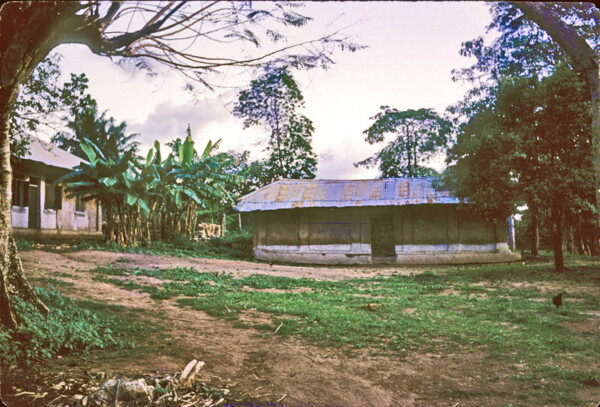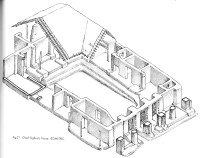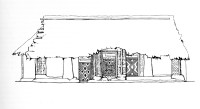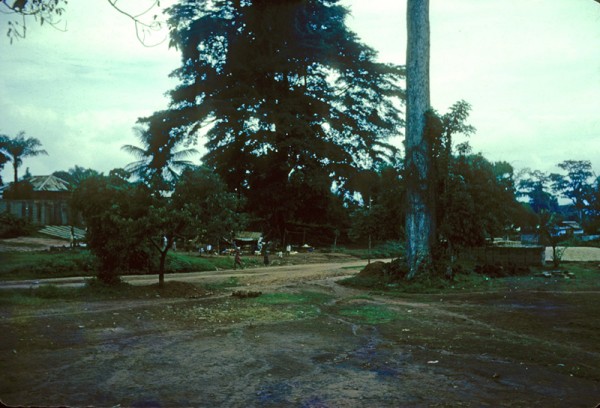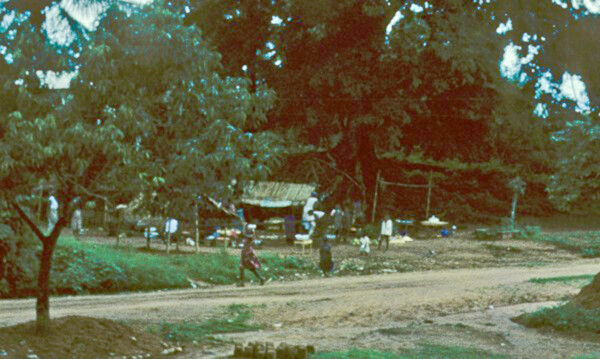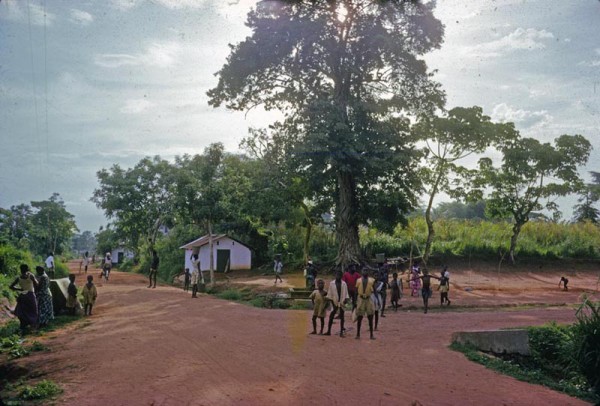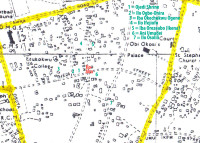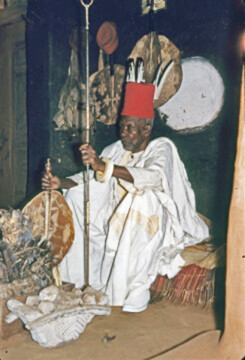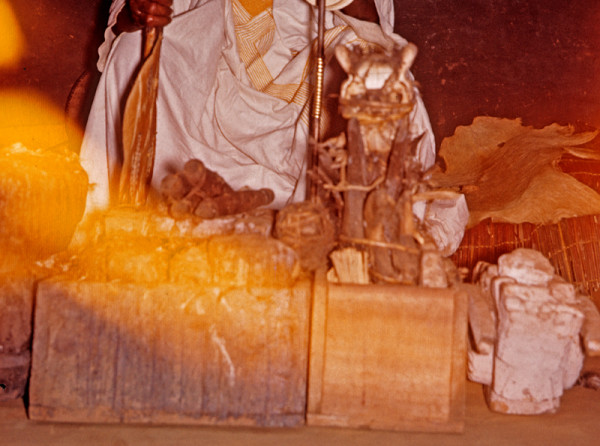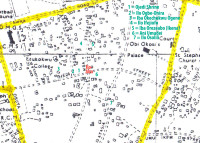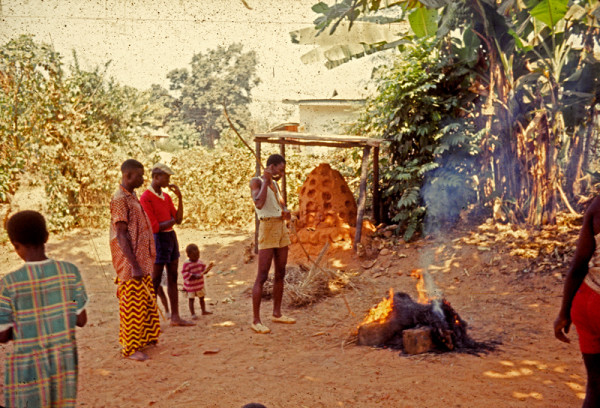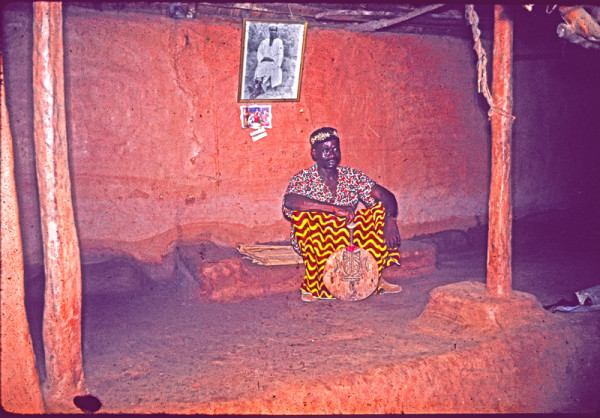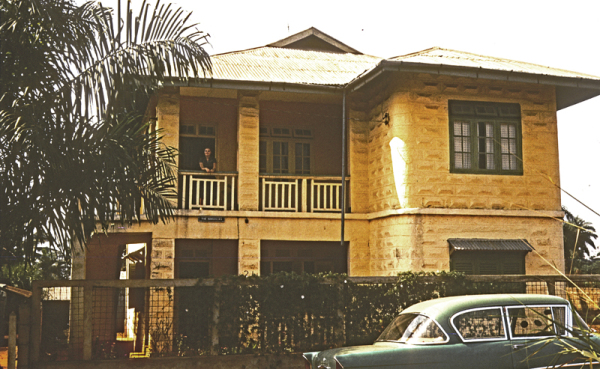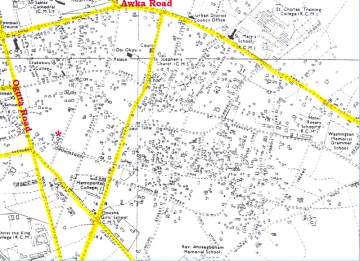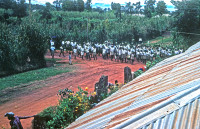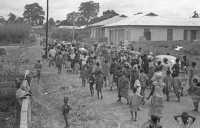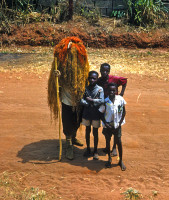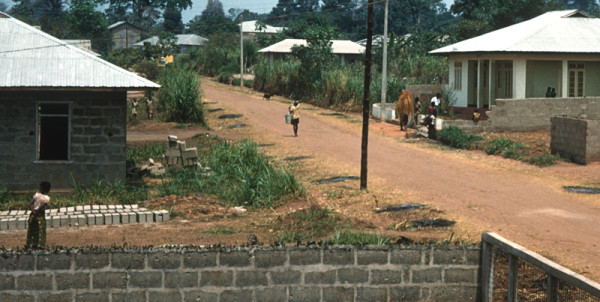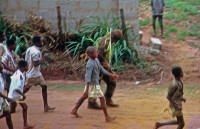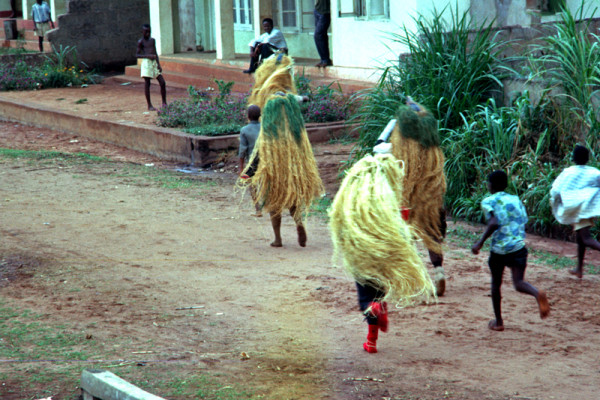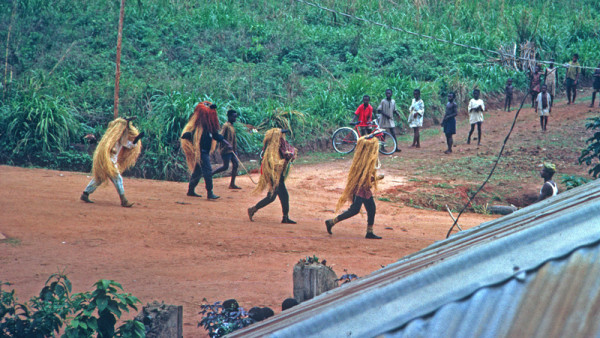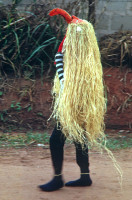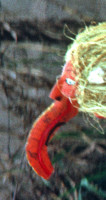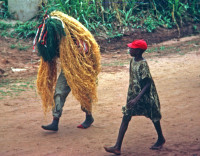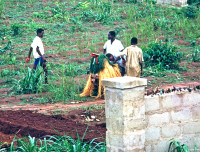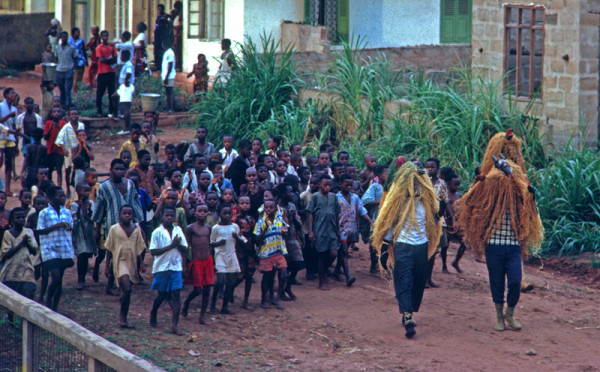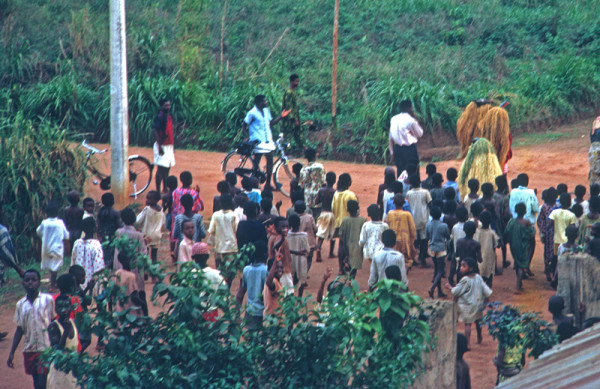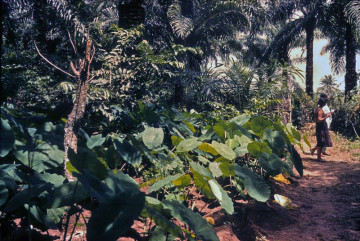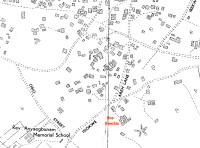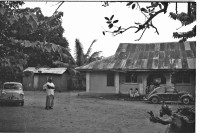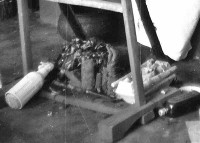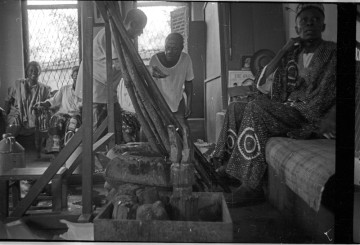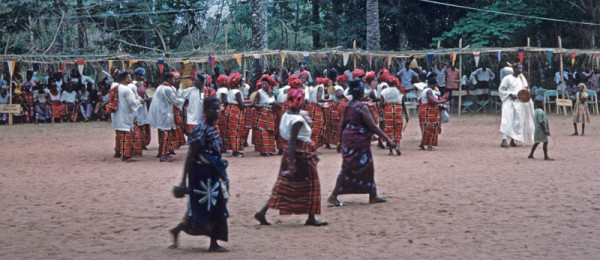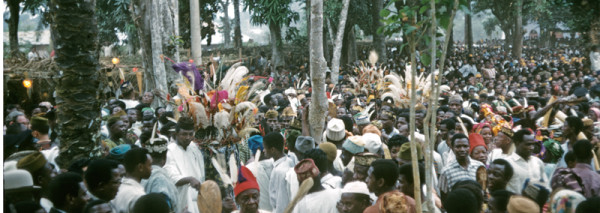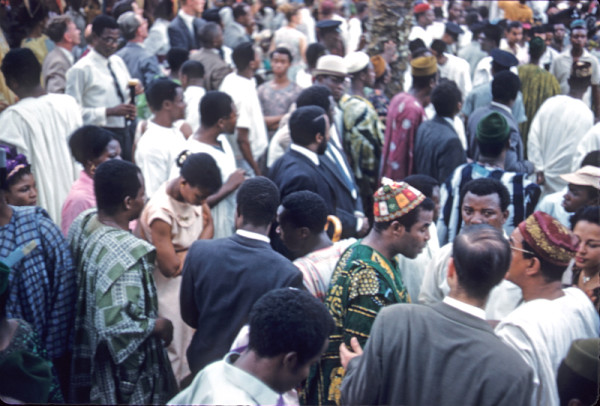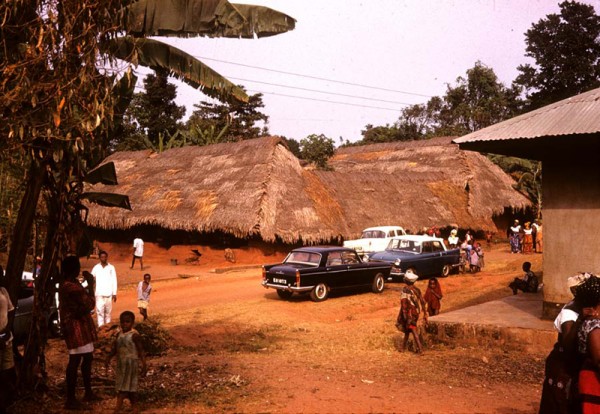
1. Landscapes, Buildings, Bodies
[Note: Click on any image you may want to enlarge.]
Writing of her brief residence in Onitsha in 1937, Sylvia Leith-Ross described her experience after living for a while amidst the “busy-ness” of Onitsha Waterside (Otu), when she finally arranged to enter the Inland Town: 1
“It’s like passing from modern times to the middle ages, from reality to a dream. You are in noisy, bustling Waterside, amid hurrying footsteps, wide streets, semi European houses, a clang and clatter of lorries, shouts, colour, sun; you cross a road, and you are in a silent gloom. Huge trees overshadow high mud walls, narrow lanes twist between, there is not a sound, not a passer by; the sky cannot be seen through the roof of foliage; though not dead, life has retreated; it goes on behind those walls… secretly, noiselessly, cloistered in its own memories, with all sorts of old… beliefs and customs and conventions.”
In 1960-62, Sylvia Leith-Ross’s description seems like something out the “Middle Ages”. There is still a stark difference from the Waterside as you enter the Inland Town . There is indeed a sharp contrast in the sense of entering a giant garden rather than a “buslting downtown”, but these verdant zones no longer seem closed off, and Ms. Leith-Ross must not have visited often or for any length of time, since sthe sounds are not silence: there is magical drumming, singing, and thehigh mud walls are gone, concealmenthas been replaced by open dirt roads. While we have seen no detailed images of that world from those times, the former “closure” has been sharply broken (since 1949) by roads, and motor vehicles convey viewers past many central spots. The central open spots, called ilo (I translate that as “village square”) often fill with activity.
In 1962, the scene is much more open (very little “gloom” confronts our eyes), but still very verdant. Small tropical-vegetable gardens are scattered everywhere and giant trees still dominate the landscape. Smitten by visual beauty, we voice our preference for it over the Waterside very soon after our arrival, only to hear our professional Onitsha and other African friends express surprise and disagreement, saying they find the Inland Town “dirty”. They decisively prefer the Waterside, with all its various signs of Modernity, a preference partly associated with a considerable prestige for cement block as a building material, more I suspect for readily-available electricity, indoor plumbing etc..
But I am sure that these people (characterized by the authors Hugh and Mab el Smytghe as “The New Nigerian Elite”, 2 also chose the Waterside because of the very distinctive social life incumbent upon those who live in Enu-Onicha. hile the Waterside is much more intense in the experiencing of crowded clusters of concrete-block buildings, paved roads with fairly continuous automobile and other business traffic, many people moving about (mostly males, mostly unfamiliar),and little vegetation; when you cross to the other side the intensities radically change: a sharply different social life becomes necessary, social spaces occur where connections between land and sky seem much more organic, but the social activities ar e much emore highly organized and the vital statistics are quite different in the two places. The social life can become very intense indeed for Ndi-Onicha living there (which is one reason quite a number of them choose to move elsewhere).
Below, looking westward along St. Stevens road from a position near Ojiba Lane, a view of Ilo Ogboli-Olosi, the sacred village center of this major Onicha village where important meetings are held under the protection of resident Alusi Spirits. (Map locations are shown at the right.) The great trees standing at the corners of the center contain such overseeing powers, and an Omumu (Birth shrine) is located at the right side of the Ilo (out of view for this image). (Note also the large and modernistic-looking, walled residence building at left-center of the image.)
Below, not far to the south (left) from the previous viewpoint, high on the hillside stands the Iba 3 of the great Ogene (fifth Senior Chief) EzeOba, who challenged and even overshadowed Obi Anazonwu during the last years of the 19th century, finally proclaiming himself as a King equal to the Obi Onicha himself. His usurpations were stopped only when the newly-entrenched Royal Niger Company arrested him (for slave-dealing) in May of 1898 and confined him across the Niger in Asaba (where he died a few days later). His Iba remains closed to this day (as of 1962).
The type of building we see here is distinctive to Enu-Onicha, and contains important ritual meanings.
Here we see architectural renderings of a similar house located elsewhere in Enu-Onicha, at left showing the typically much-decorated frontage of this kind of building and at right details of its interior design, with an internally-draining atrium, a priestly altar at upper left in the image, and domestic rooms surrounding the open inner courtyard. 4 In Onitsha these buildings are the classic form of Iba (Ancestral House), an architectural ideal that links them toward the Kingdom of Benin far west of the Niger, rather than to most Ndi-Igbo villagers dwelling to their east. 5
Below, Ilo Ogboli-Olosi viewed at ground level. Note the small marketplace sheltered under the protection of Ani-Olosi (the Mother-Earth shrine and sacred tree of Olosi). A trading center of historical importance, it is now a small, local remnant but still subject to the traditional rules of Ani.
Below, a closer view of the tiny marketplace, (Afia), a very different venue from most of Otu and operating under different rules. The traders here are almost entirely female.
So this brief moment takes us into a world very different from that of Otu, a world organized into villages that reek of their history, marked with shrines that designate and uphold village cooperation, creativity, and change.
Below, the Sacred Grove of Ogboli-Eke, sister sub-village to Ogboli-Olosi, stands as the largest cluster of high forest remaining in Enu-Onicha (following the destruction of Okwu-Eze after Obi Okosi’s death in February 1961). Where a stand of high forest remains like this, it is associated with Spirit (Alusi), and has some of the character of “Bad Bush”, where dangerous forces accumulate.
But it is also a major shrine, one that that Ogboli-Eke villagers are bound to render service and which they approach with reverence.
2. Highly Organized Villages
Below, looking westward at the crossroads of Mba Road (here running right-to-left) and Ojedi Road (from foreground to upper left), stands the great Ilo-Aba of the people of Umudei-Aba (one of the two major divisions of Umudei Akanabo, (“Children of Dei of two hands”), the site of that group’s plenary meetings, held under the protection of the Ojedi shrine (housed in the whitewashed building at middle-left). Children of these villages here play (as they have done from ancient times) in and about their Ilo center, under the protective cover of their reigning Spirit powers. These “Children of the Ilo” (Umu-ilo) have definite rights and duties under the label of that status (unmarried), related to the location and its people. (The Ojedi Alusi , tracing its identity to an ancient Daughter of Umu-Dei), is one of the most powerful and famous of the Inland Town.)
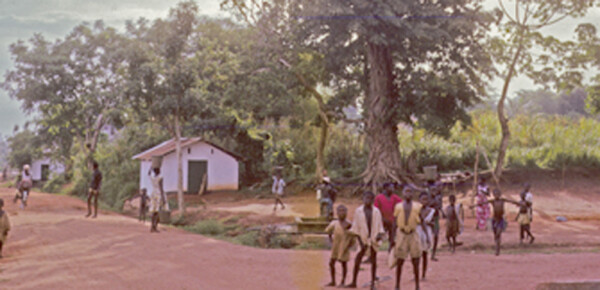
At right, a map that centers on this location, oriented to the north (while our image looks westward). You can see on the image above that location (2), labelled Ilo-Ogbe-Onira, has another white shrine house at this location (the “Village Square of Onira“, the lattter a founding ancestor of this sub-village of Umu-Dei-Aba).
No. (3) on the map designates the iba (Ancestral House) of one of the great leaders of Ogbe-Onira during the early 20th century. His name was Okechukwu, the Ogene (his title name as the fifth-Senior Chief of Ndi-Onicha). Here see his home, one of the first two-storey buildings of this type in Enu-Onicha. The Ogene was one of the early “Warrant Chiefs” selected by the newly-established British Colonial Authorities to act as one of their local agents (mobilizing resident labor to build roads, etc.). Amassing very considerable wealth in this capacity, he eventually built as his monument this two-storey building, unique in Onitsha of that time with its concrete-block lower portion and wooden-frame first story. It bears a strong resemblance to the late-19th-century canoe-houses of the chiefs of Opobo (and other Rivers towns). (See below in Chapter, the page entitled “Visit to Opobo 1961”.)
No. 4 on our map indicates the location of Ilo-Ifejiofo Family of Umu-Dei-Aba. Most prominent within this sub-village are members of the Onyeachonam Family, notably here the Ojiabu — his title as one of the Ranking Chiefs — Ndichie-Okwa — working to manage corporate affairs of Enu-Onicha. As a junior chief, he contgrols one of the subdivisions of Umudei.
Local Ndi-Onicha direct me to visit the Ojiabu very early in our stay (he was regarded as a great expert in Onicha culture and history, partly by virtue of his very advanced age), and he greets me at his Ancestral House and wearing his full regalia.
I am unprepared for the visual aspects of our meeting. In response to my questions, he is not forthcoming, rather seems a bit hostile to find himself quizzed by a youngish and casually-dressed Onye-Ocha (“white person”), and he deflects most of my questions with faintly defensive, almost sarcastic remarks. But as I look at his regalia — the chief’s cap, the diverse array of chief’s fans draped about him, the Ogbanchi forked brass spear , and then at the panoply of objects layed out before him on the floor ( his “altar” — Iru-Ukpo), I realize I am dealing with a social and personal world of great symbolic intensity; In the foreground of the image above, his own personal Okwachi (itself a complex symbol of one’s unique identities and their requisite purifications). Looking now to the image below, an array of Ikenga Spirits (icons of what social psychologists in the 1960s call “need-achievement”), multiple in nature and scaling in size, each bearing skulls of sacrifice. Directly in front of him, the Ndi-Mmuo (ancstral ghosts, both named and unnamed), topped by a set of chieftaincy-defining Ofo-sticks of distinctly phallic shape (emblems of righteous power — these are the very dark sticks atgop the boxes), and directly below the dark sticks, an array of Okpulukpu — ancestral Treasure Boxes owned by named deceased titled ancestors (each containing objects associated with that still-present person). I recognize that these many objects signal important aspects of identities, both personal (the “I’s”) and social (the “we’s”), but how the complex might work as symbolic directives for the ordering of Enu-Onicha lives I can scarcely begin to guess. 6
Below, we see Ojiabu with his various fans and his Chief’s bag. I did not explore the significance of these different fans. The bag at right is a distinctive feature associated with chiefs: whenever a chief goes out in public (traditionally), he is preceded by a young acolyte who carries on his person thie bag, (containing the chief’s “paraphernalia”) so the attached bell clangs as he walks, warning people nearby that a chief is coming (so lesser persons are warned to move rapidly out of the way).
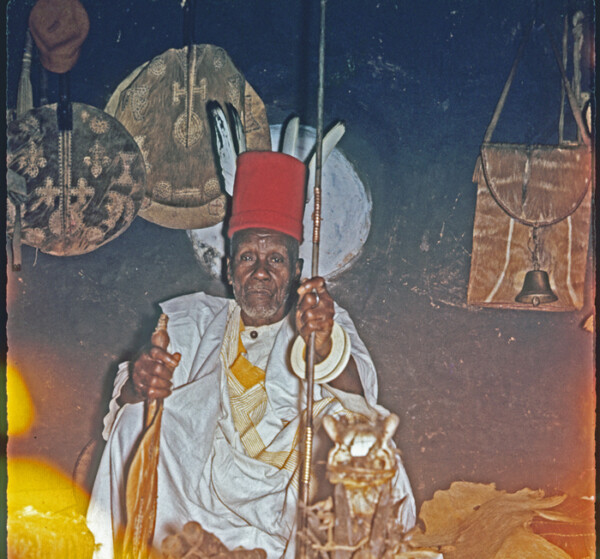
Not long after my visit, the Ojiabu dies, and I am soon allowed to attend my first funerary event involving a deceased Onicha chief. I take no photographs at this ritual, which is held in and around Ilo-Ifejiofo,where I witness the Ojiabu‘s actual reincarnation in the form of a Mmuo-0gonogo (“Tall Ghost”), one of the most feared of the Masquerade figures in Onicha. This Tall Ghost is escorted to the funerary site by several other figures of this class, each entirely cloaked in sumptuous Igala cloths, as is he, but his own dress is stained by blotches of fresh mud acquired from his recent, initial journeys in Ani-Mmuo (Land of the Dead).
Not far from Ilo-Ifejiofo in the map at right you see No. 5, the site of an Ilo associated with the Umu-Orezeabo sub-village in Umu-Dei-Aba. This place marks the house of a man who becomes one of my most valued companions in all Onitsha, T.C. Ikemefuna (usually called “Ikena”). He enrolls as one of my most reliable guides into many zones of the Enu-Onicha World.
This location below is,Ilo-Umu-Orezeabo, where Ikena is Di-Okpala since his father died. This small square contains all the crucial attributes of an Ilo, including a flank of banana trees (at far right), placed to encourage Spirit Children to come and join the group, and an Omumu (Birth) shrine, here an oval clay mound in which plates are embedded, representing the wombs of the Village Wives (Ikporo-Ogbe). Here he oversees the initial burning of the hair off a just-sacrificed goat (preparatory step before the ritual division of the meat of the animal).
(This ritual will be discussed elsewhere). Below, Ikena sits inside his father’s Iba, the deceased’s photograph placed prominently over his head. He sits on his father’s throne (Ukpo), with the presence of its altar (Iru-Ukpo) signaled by the twisted rope hanging on the support pole at right (intended for placement of the Ossissi (Ozo-title Staves). (Note to the right of the Throne (from Ikena’s point of view), inconspicuously drawn out along the floor-wall boundary, a series of “decaying” clay mounds. These are shrines dedicated to the Daughters (Umu-Ada) of the descent group to which the Householder belongs. Less evident but also present left of the Throne are Oma-Nne, shrines to the “Mothers” of the group. Both these spiritual connections link the householder to people bound with him through these female descent-group linkages.
Although he has performed the burial of his father, before he can succeed him as lineage Priest (which is accompanied by important measures of control over the lands connected with both village houses and the farm lands at the peripheries of the town) he must begin a process of “Bringing the Father In”. We will examine this process elsewhere.
Setting aside further details of the village organization in Umu-Dei (and its larger unit of the Royal Clan, called Oke-BuNabo (“Division-is-Two”), let us now turn to another set of Enu-Onicha features we begin to encounter early in our residence there.
3. Hendersons reside on the “Edge”, in Iwoliwo
Below, see the residence of Helen and Dick Henderson during nearly our entire stay in Onitsha in 1960-62. This location — the upper storey of 24 Mba Road — is an excellent choice for us: part of the Inland Town, but somewhat peripheral (Iwoliwo designates a semi-bush location) so not continuously over-run with the social activities of a central village address. (We were almost directly south of Ikena’s house, also located along Mba Road.) Our place was linked with Umudei Village, though its formal connections were to Isiokwe, a village well off to the east.) The upstairs balcony (off the living-room) is well situated for viewing events on the street.
When we arrive in 1960, the Inland Town boundary is still marked to the west by the Oguta Road running southward from the Roundabout, and to the north (though more roughly) by the Awka Road running east from the roundabout (dividing the Inland Town from the European Quarters still housing mostly Government establishments and officials). Behind this perimeter, the indigenes actively defend their “High-Onitsha” (enu-onicha) space, using such mechanisms as forbidding land transfers to outsiders and mobilizing the Incarnate Ghosts Masquerade organization to intimidate interlopers, and although the boundaries have become permeable (with both immigrant ndi-Igbo and Ndi-Onicha neighbors residing next door to us), those living inside this space are either “Ndi-Onicha” or else they are transients. (We are granted provisional Ndi-Onicha status, living directly above our Ndi-Onicha landlords.) The southern and eastern edge of the Inland Town is marked roughly by the school establishments visible on the map.
While by 1960 there are many more European style houses and corrugated tin roofs dotting the Inland Town than Leith Ross described for the 1930s, the contrasts still obtain between continuous noise vs. frequent silence, between the Waterside’s omnipresent building construction materials/activities, throngs of traders (mostly men), and horn honking, madcap driving motor traffic, versus the Inland Town’s silent gardens, houses of traditional design, patches of high forest, small groups of women sitting in small and casual village markets beneath great trees, occasional orchestras accompanying brightly-costumed groups moving in aurally enriched dancing formations.
So we rent the upstairs flat at 24 Mba Road (the red Star marks its location on the map) for £12 per month, which at that time is about the limit of what we feel we can afford. The flat is luxurious by typical ethnographer’s standards of the 1960s (which typically extoll much more ascetic conditions), with electricity, running water (usually), and an indoor bathroom and toilet. The owner of the house is Ozomma Albert Erokwu, an Ozo-titled Onye-Onicha serving as a Produce Inspector for the Federal Government, who bought the land from another Onye-Onicha and he is now living in the downstairs flat with his wife Merci and their four children. They are congenial and accommodating hosts. We are in fact very lucky to have made this choice.
The Inland Town resounds with frequent but distant music by day and (often) into the night, and (as ethnographically entranced semi insiders) we enjoy the periodic visual, aural, and social emergence of unfathomable mystical forces from nearby patches of forested bush. The traffic in people and vehicles is light enough in that peripheral location that we can work in our home without much distraction and, sometimes play badminton out in our yard without being continuously yelled at for our foreignness. (On one occasion, we are called Okeke-ocha (“Bush-Whites”) by a passer-by, but it is unusual for us to hear such contemptuous comments.)
Our entry stairs are to the left, the living room door and windows at the top of the stairs, while the kitchen (with wood-burning stove) lies beyond that room to the rear). We use the room at far right for our working office, while a similar-sized room behind it (and beyond the bathroom) serves as our bedroom. In 1960-62, Onitsha buildings of this kind lack screens, so we use mosquito netting over our bed, and occasionally one of the many bats living within the attic of the metal roof makes an unannounced (and feverishly discouraged) evening visit (the badminton rackets serve to discourage them from taking up residence in this lower leve of “their house”).
The houses immediately to the north are part of Umu-Dei Village. (In 1960, Umu-Dei buildings have encroached much closer to us than shown on this 1950s map, and a set of rental buildings has also sprung up across the street.) At the bottom of the map, UgwuNaObamkpa Road provides an east-west route leading into the heart of Enu-Onicha. (Unlike Oguta Road, which is tarred, UgwuNaObamkpa Road remains a dirt avenue.)
From our vantage point upstairs we often have good views of significant events. This moment at right is our first: schoolchildren from nearby Metropolitan College marching down Ugwu-NaObamkpa Road toward the Waterside to participate in the Nigerian Independence celebrations of October 1, 1960. The students dance, cheering with jubilation, and we reply in similar spirit. (note the yam garden visible in its lighter green coloring in the middle of bush, at upper mid-distance in the image. Iwoliwo retains spaces of this kind.))
We have Ndi-Igbo neighbors who are renting quarters to our immediate south and east, but with the Dum Omodi compound (Ndi-Onicha) to our west and Umu-Dei families to our north, we know that our house is located within the bounds of Enu-Onicha. Below, when we look west from our kitchen balcony toward Oguta Road, we always confront the Dum-Omodi compound, shown here below (beyond the iron roofs running horizontally across the image; the lower portion of the image shows “servants’ quarters” for our two-storey housing complex).
Below, you see the complex clearly: an array of four different lorries parked in a group in the front of the compoud. In 1960, this clearly marked the location as a non-Onitsha residence”.
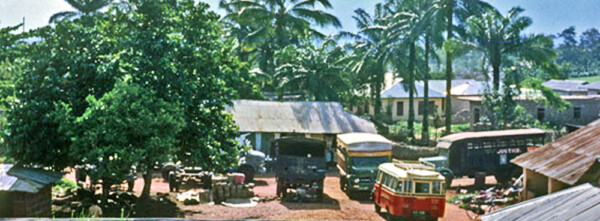
Dum-Omodi was a prominent Onye-Onicha, who we understand sold this location “freehold” to a non-Onitsha (Onye-Igbo) man, who is now owning/operating a commercial transport business at this location, often a scene of commercial activity and where small children there who spy us standing on our balcony immediately begin dancing in place while loudly chanting “Onye-ocha” (“white person”) in unison. They are not Ndi-Onicha, so they don’t learn who we are. We’re in effect looking over a sharp social boundary between Enu-Onicha (where we live) and Otu (though in 1961 we hear that Dum-Omodi‘s sons are seeking to regain title to the property through litigation).
Below, this view looks from one of our upstairs windows toward the northeast. Traffic, both motorized and otherwise, is relatively infrequent along Mba Road. But it is not dull: below, a confrontation develops between a magic-ring man and a group of curious observers who are pestering him. Where he came from I do not know (he is a non-Onicha), but as the onlookers creep closer to him from behind as he walks along Mba Road, he turns and approaches the crowd, thrusting his magic ring in front of him, and they retreat (in a show of awe regarding its power), at a speed commensurate with that of his stride. Having ensured their deference, he continues on his southward path (and they follow, closing the gap). this ritual entertains them (and us) for the better part of an hour (after which the non-Onicha intruder departs).
Below, you can see his arm extended, while his “doubters” nevertheless keep their distance. (The game must be sufficiently fun — for both small children and considerably older persons — to continue it for quite a while.)
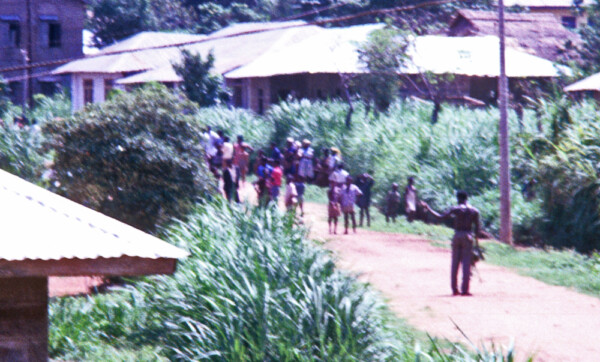
Soon (despite our intention to study Onitsha (“as a whole”), we are drawn intensely into enu-Onicha affairs. Below, a children’s dancing group from Umu-Dei, making its performance rounds of all Enu-Onicha villages, includes us in their routine. These groups are highly and effectively organized, with a Mother and Father of the dance, as well as a stylishly-dressed Patroness, while a talented orchestra provides complex rhythms for the dancers, who — clearly marked with their uniforms — display real expertise. We are also quite impressed by the large crowd that follows them as they continue on their rounds.
4. Boundaries Policed by Incarnate Dead
The Ndi-Onicha Mmanwu7 regularly clarify the nature of our residence location: we are residents of enu-Onicha, where the incarnate dead presume to walk among us, and police the perimeter as well.
On one occasion, a lone Ulaga Mmanwu saunters casually along Mba Road escorted by Ndi-Onicha Initiates. They sometimes pause to greet us, tolerating our presence in our protective location (so long as we don’t try to approach them closely).
Below, he stops to greet some initiated youths of Umu-Dei. But note the woman standing hesitantly at far lower left in this image. She wants to see this figure, but knows that if he sees her she must run, because Ulaga will chase her with the whip he carries in his hand. (And veritably, women beware: the Ulaga may be and sometimes are used to expel an unwanted wife from her marital home, see the Nigerian Spokesman December 15, 1960.) Ordinary women must flee from the Incarnate Dead.
On another day, an Otu-Iche Mmanwu shuffles more rapidly in its bumbling way, tended and guided as usual by youth of his village (it throws oranges and other fruit at any unauthorized bystander).
More startling (and beautiful) figures are the Ulaga, below, who embody the youthful dead in mostly birdlike forms, with flowing, featherlike bodies and long legs, who run through the villages with vigorous grace, often focusing their aggressive chases on young women (who flee from them with great haste, as do any male children who remain uninitiated in the secret rites of the Mmanwu, Incarnate Dead.)
Below, Ulaga will accost any person who fails to give way soon enough, in this case an Onye-Onicha, a native of Onitsha Inland town. passing through on his bicycle as he returns home from work. The Ulaga demands a gift even from this fellow-initiate before allowing him to pass. Here, the man pleads his lack of funds, hoping to joke his way past this unpredictable (and often impulsively aggressive) person.
Matters become more serious below when the Ulaga confront an Onye-Igbo, a non-Onitsha person who presumes to course through the Inland Town. This man stands uncertainly as three Ulaga approach him, accompanied by their Village Youths (Umu-Ilo). He has no chance of getting past them without paying a considerable fee, and he may think twice before walking again along Mba Road.

Note that the two front figures are variant forms of creatures with heads representing crocodiles. The Ulaga forms of Masquerade are associated with the Ijö people of the Niger delta8. Ndi-Onicha have an old historical association with the people occupying the riverine lowlands, known collectively as Ndi-Olu, and have adopted a number of their cultural forms.
We Mba-Road spies learn that this is no ordinary occasion when we see a substantial array of women proceeding purposefully down Ugwunobamkpa Road toward the Waterside. These are women associated with an event ivvolving Umu-asele Village, with a set of Daughters (Umu-Ada) in front and an Age-grade (Ogbo) behind.

A Funerary moment is underway in Enu!
Soon after the women have passed, a team of Mmanwu appears in a group, coming from uphill on UgwuNaObamkpa Road:
Note that their beaks display a considerable variety:
One of thes figures in particular I have never seen before; a mysterious figure indeed:

This time they are accompanied by their orchestra of Umu-ilo (“Children of the Village Center”),– I am unsure of what instruments may be involved here, beyond their complex-rhythimic clapping of hands — indicating the start of a formal event (rather than the mere casual “patroling” of Enu-Onicha turf that Ulaga often do):
This begins a considerable period of wandering behavior along Mba Road by these creatures, one of whom affords us a close view of a Hornbill-like head, at left. Note the recessive humanoid face at the top, which only becomes visible to a confronted person whenever this approaching Ulaga suddenly drops its beak (modeled here at right).
After extensively chasing various people along the street, one member of the group (above left) appears to experience some difficulties in his upper body. This is remedied by the (UmuAse) Village supporters, who escort him offstage to make the necessary repairs more or less out of view (note the gardens occupying parts of this enclosure).
The creatures attract a remakrably large crowd of children. All of these must be initiates into the Mmanwu, amd they are [rpbab;u frp, several Ndi-Onicha Villages — Umudei, Obikporo, etec as well as Umu-Asele.
Eventually, the various figures assemble with a large escort of Ndi-Onicha, who march forward along Mba Road together: Arriving at the crossroads with Ugwunabamkpa Road, they block potential through-traffic (despite the complaint of one bicyclist).
And then the meaning of this entire event becomes clear, as a large number of adult members of UmuAse Village come dancing up the road from the Waterside, bearing the coffin of the young UmuAse man who died there this morning, and is now being borne to his natal home in Enu-Onicha for burial. (Note the Ulaga in the foreground, standing guard as the procession passes.)
The men are in front, the women behind. Some of thes folollowers may sinply be age-mates, or relatives of the deceased through maternal links, etc.
(Note the broken-glass teethmarks surmounting the wall in the foreground. These indicate the presence of strangers; we are on the edge of the Inland Town, not in its Heartland. Broken-glass wall-tops warn us that intruding thieves may lurk about. this event made clear that Mba Road is a sort of throughway for people moving east-west along this boundary street on the edge of the Inland Town)
5. Villages Mean Social Commitments
When we leave this peripheral boundary zone of the Inland Town and venture further uphill into its more central locations, such barrier warnings as broken glass atop walls disappear (in 1960-62), replaced (as at right) by woven-stick fences designed to exclude domestic animals from the contained gardens (mainly the ubiquitous West African Dwarf Goats, see one standing at middle right in this image), like this one located in UmuAnyo Subdivision of UmuAroli.
Small, well-tended gardens are scattered through Enu-Onicha, like this one at right beside the home of Akunne Uwechia in Isiokwe village, here showing Helen around his yard. Akuune Uwechi lives on the southern edge of the Enu-Onicha village of Isiokwe, a major (and ancient) unit of Enu-Onicha.
His house is substantial, metal-roofed and multi-chambered, located near the outlying farm lands of the village.
He maintains a household that carefully attends to “Native Law and Custom”, and carefully observes major rituals of the community.
Here, Akunne Uwechia sits on the rather elaborate throne 9 of his Iba, accompanied by his sons and other males of the family. His altar arrangement is a framework fairly typical of what is required for a house with high ceilings. At right see a closer view of his collection of “Idols”, with a gleaming white Okwachi ark on the right, a modest-sized Ikenga, the sticks representing Ndi-Mmuo, and at left, a single Okpulukpu, but this Ancestral Treasure Box is completely covered with the feathers and dried blood indicating frequent, devoted sacrifice. (This is noteworthy as a sharp contrast to a set of these Treasure Boxes I once saw in another village location, where one of the visiting elders commented disgustedly, “These Okpulukpu have never tasted blood” (in other words, have suffered total neglect by their holder, who should be their devoted servant). Akunne (his Ozo-title name) has definitely “brought his (deceased) father in” to the house, a ritual act pre-requisite to taking that coveted title, but the Okpulukpu in focus here is that of the late Uwechia Onya, a great Onicha Senior Chief of the early 20th century whose influence reached beyond Isiokwe or Odoje Villages in Enu-Onicha, extending throughout the Inland Town and beyond. He is an ancestor eminently worthy of ife-nru (rendering service) and Igo-mmuo (begging the ghosts), evidence of which you see on the richly-covering array of feathers etc.
In the wider realms of Isiokwe Village as a whole in 1961, the reigning Senior Priest (Di-Okpala) is Nnanyelugo Emembolu, who occupies the Throne for all of Isiokwe when situations arise requiring all segments of that group to meet.
This is done at Uno Isiokwe, a newly-built place of descent-group assembly shown at left. On the morning I arrive to participate, Isiokwe girls are walking with their lunch boxes, heading down Areh lane in the direction of other parts of Odoje (along Ugwu-NaObamkpa Road) where they are attaending school..
on the occasion shown at right, Isiokwe’s Diokpala, Nnanyelugo Emembolu (seated on the Throne at far right) has assembled pivotral members of Isiokwe together with representatives of other descent groups to discuss matters of importance to everyone.
These may include a wide variety of interests: issues concerning the disposition of village lands, the planning of seasonal rituals, aid to villagers in trouble, the organizing of funerals for the newly deceased, etc. Village subdivisions and individual villagers must must first mobilize resources, activate cooperative groups, and then notify all affected associates of the the problems at hand.
6. The Primacy of Ozo Title in Social Life
Organizing these actitities requires men of authority, and in Onitsha the main figures having prestige enough to warrant authoritative respect are Ozo-titled men. The taking of Ozo title is a primary goal of nearly all Ndi-Onicha men. It entails an elaborate series of self-purifications, which eventually entails contributing widening series of wealth distributtions to others (focusing most largely on already-titled men).
Below, see a newly-titled Ozo man, dressed in pure white, carrying his new Ozo staves of authoirty (ossissi), wearing his Fish-eagle feather (ugo), surrounded by fellow Ozo men (one carries an emblematic elephant-tusk horn), and followed by a virgin girl carrying his Okwachi (representing the dimensions of his purified self).

Beloow, at right, a group of Ozo men, identified by their feathers and ivory horns, lead the women of their age-grade (ogbo) marching at a funeral being directed by their age-mate acting as the Head Mourner (the man in red cap).
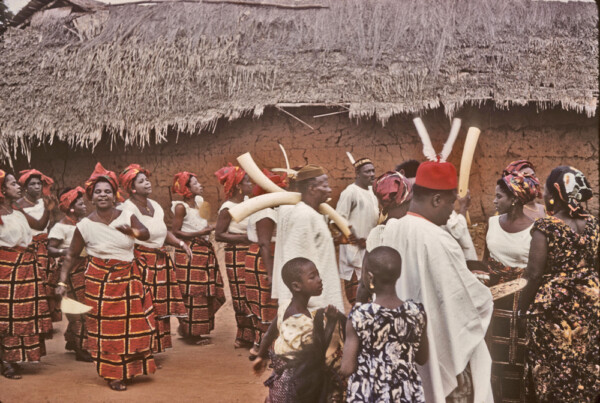
Below, the Onitsha King (Eze-Onicha, the Obi onicha) emerges from his palatial seclusion (in October of each year). Only an Ozo man from this lineage is eligib le to become king.
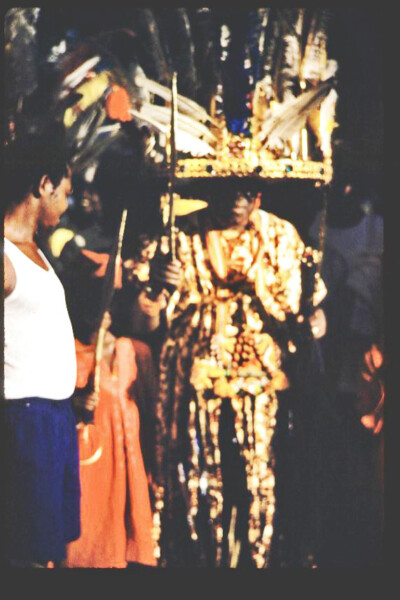
And below, royal ancestors also emerge as Incarnate Dead (MmanwuI), here the mighty Ijele figure roams the Inloand Town, escorted by the men of a senior Age-grade. The organization surrounding the Mmanwu possses great power, even the potential right to sanction a reigning King (and to kill any ordinary person who defies them).

And many events require elaborate ritual preparations. For example, at one burial event involving Isiokwe, the related community (a village-group) named Umu-EzeAroli came to participate:
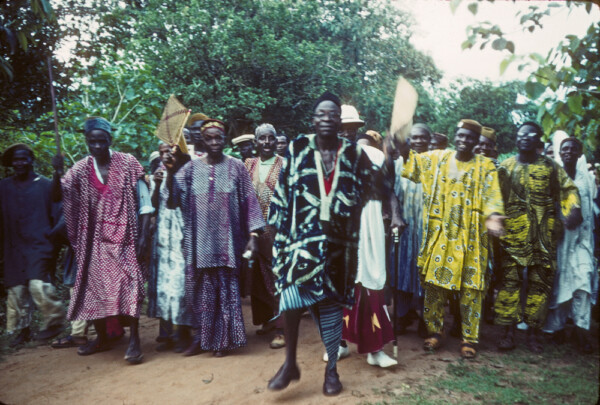
Note here, first, the garb worn by these men. Ndi-Onicha do not dress casually for ritual occasions. They are each resplendent in particular ways. (Ndi-Onicha are widely known for their investment in various modes of elegance.) Second (though this is not so obvious in this image), they are mostly elderly, “retired” men (who tend to occupy the front) while young men are mostly in the rear. An exception here is Michael Enwezor, the man wearing glasses toward the right, an actively-working Nigerian Government official stationed elsewhere but currently on leave. (Being present in Enu-Onicha, he must participate. To decline would be “unthinkable”.)
So the vital statistics of Enu-Onicha contrast with those of Waterside. At ages where people are likely to be pursuing careers, men are scarce here, because they are strongly engaged in regional or national (largely governmental) pursuits . Women of that age, in contrast, are plentiful (because they have had much less opportunities in such fields, are in a sense like 1950s American females mostly expected — indeed, required — to be “homebodies”). This contrast may be readily seen in one of their important Inland Town social activities, for example in the Age-Grades. These, the Ogbo (also called “Otu-ogbo“, Age-grade Association), have been integrated by gender in Enu-Onicha for many years, and they are very active in Enu activities like funerals. Here is a good example: “Douglas Age-Grade” (marking the age-range of those born between 1906-08 during the tenure of a British official widely known as “The Black Douglas”), as its members dance their way into the funeral of Obi Okosi II in March 1961:
Here the ratio of men (mainly at the rear, except for the leader) to women is roughly 1:3. This is fairly typical for grades of these upper age-levels. Most of the missing men are professional or semi-professional workers, largely engaged elsewhere in government jobs (some of regional, national,and even international importance).
These age distributions appear to hold for all Enu-Onicha villages. It is largely the elder men who controllocal village affairs, including that potent good, village lands. We will consider this subject in greater detail elsehwere, but here let us note that the villages each control “house lands” — the lands where they build and maintain their village homes, and the gardens, shrines, and pathways associated with them, and “farm lands”, lands extending outward from the perimeters of the villages that were in former times dedicated to farming (and still to some extent serve that purpose). The maps attached here give readers some idea of what is entailed: on the left, the distribution of 1960s major villages in Enu-Onicha, roughly indicating their houselands (we omit several of the very small villages in this diagram, which is intended merely to give readers a general idea of the picture); on the right, a copy of the map I presented in 1972, giving a very generalized guesstimate of the spread of village farm lands peripheral to housing (a distribution reconstructed for about 1880).
The villages of Enu-Onicha experienced inter-village conflict over house-lands from the very beginning of British Colonial power (and long before that in all probability). But with the expansion of Onitsha as a Township and eventually an “Urban district”, the value of the farmlands began to increase at far greater rates. Onitsha villagers have become to varying degrees landowners, and in many cases very substantial controllers of this fundamental source of urban wealth. Herein lies a source of major social activities, and it is no wonder that, while so many of the young Ndi-Onicha travel elsewhere during their working careers, they are unlikely to lose interest in their homeland entirely. The forces maintaining their attachments are powerful ones, and these include the skyrocketing values of land.
6. Absent Sons and Daughters Are Important
We must remind ourselves of the following quotation, written by the great student of Igbo (and “Ibo”) society and culture, G.I. Jones:10:
…by the end of the first world war Onitsha Town had become the most important educational centre in the (Eastern) Region, a position it has retained and expanded — there are no less than six secondary schools there today. The people of Onitsha were quick to profit by these advantages, and the list of famous sons of Onitsha is staggering when one considers its small size.
Within this quotation, Jones clarifies exactly who these “sons of Onitsha” are: he says, “This refers to the original community now distinguished as Onitsha Inland Town.”11
Most (but not all) of the famous (the very wealthy and mainly well-educated) choose to live elsewhere than the Inland Town. We will write regarding some of these people at various points in this work, but our interactions with most of them while we are in Onitsha in 1960-62 are relatively few. My graduate student’s grant stipend provides no basis for engaging extensively with these famous sons (and daughters) and their friends. Our choice of focus is fundamentally Enu-oriented, on Ndi-Onicha “sons” (and daughters too) who continue to dwell in that place which Sylvia Leith-Ross found so strange. Today (1960-62), they are for us mostly interesting and appealing enough.
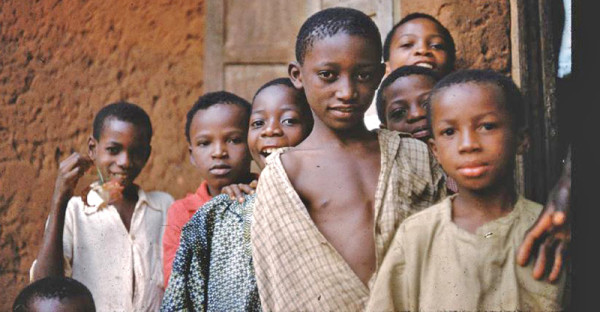
But the absent Great Ones do hover importantly nearby. Who, we may ask, organizes the kinds of resources required to produce the often-spectacular feasts of pomp and ritual that punctuate life in this dreamworld?
What roles are played by those who have joined what we now call the Diaspora, whether traveling across the globe, or often in the case of Ndi-Enu-Onicha, merely departing to live in the Waterside (or elsewhere in Nigieria, the UK, or the U.S.A.– as Nnamdi Azikiwe did ‘way bacdk in the 1920s)?
What do they do, those who have acquired the power to (in the words of an English comedy group called “Beyond the Fringe”, wildly popular in England and the U.S.in the early 1960s) “do the judgin'”?

If the number of “famous sons” (and now daughters) among Ndi-Onicha is “staggering”, the numbers of their barristers and lawyers are legion. This flow was greatly stimulated by the intense controversies arising early in the twentieth-century over control of land in and around Onitsha, a flow of human beings that rapidly became a flood. But this new world of opportunity for educated local people was but one avenue of the array of posts obtainable in government, mission education, and business operations that emerged in Onitsha at that time. Ndi-Onicha often proceeded through one-and-another of these alternatives in somewhat “hop-step-and-jump” fashion.
So, if the Ndi-Onicha who were living at this location in 1857 (when the first Western-educated Christians encamped in their midst) already “contained multitudes” of social and cultural identities within themselves and their social groupings, the education-based diaspora stimulated by the new intruders from 1857 to 1900 (and beyond) soon spread waves of increasing experiential complexities that even now challenge any effort to comprehend them. The remaining contents of this book merely continue to explore the wonders of these worlds. May the Ndi-Onicha continue to find inspiration in their past, and to continue to employ their endlessly multiple identities to productive aims.
Do I contradict myself?
Very well then I contradict myself,
(I am large, I contain multitudes.)(Walt Whitman 78:51)
…………………………………………………………………………
- Leith-Ross 1942: 30. [↩]
- 1960 [↩]
- “Ancestral House”, see Henderson 1972:147,166-75. [↩]
- Dmochowski 1990:8. I escorted Mr. Dmochowski, a brilliant architect then working with the Nigerian National Museum in Jos, when he visited Onitsha in March 1961 while studying Nigerian traditional architecture. He kindly offered me access to some of his drawings, and we will see some more examples elsewhere in this volume. [↩]
- For more details on this point, see below in this Chapter, the page on “The Ancestral House (Ibva)…. [↩]
- See Henderson 1972 for extended exposition on these subjects. [↩]
- in Henderson 1972: 353-65 , I glossed this word as “Incarnate Dead”, which still seems as good a term as any [↩]
- see Murray 1948:12 [↩]
- Note the resemblance of the framing pillars to those present in the Cathedral of St. Peter in Rome. [↩]
- Jones 1956 :27. [↩]
- Ibid. [↩]
